Common Misconceptions in Children’s Water Park Management
Audio:
Text:
As living standards improve, more individuals are allocating a portion of their earnings towards enhancing their quality of life, whether through travel, culinary experiences, or visits to water parks. Consequently, water park projects have garnered increasing interest from entrepreneurs. However, many individuals face financial losses upon venturing into this industry. Why is this the case? Let’s explore four common misconceptions surrounding the operation of water park projects.
1. Strategic Equipment Selection for Water Park Management
One prevalent mistake made by operators is blindly following trends and failing to balance the income and expenditure of water park projects. Many operators hastily adopt popular equipment without considering their longevity or heat retention capabilities. This often results in irreparable damage. Prior to incorporating or replacing amusement equipment, operators should conduct thorough research, assess the equipment’s viability, and opt for reputable manufacturers to place orders.
2. Customer-Centric Approach in Water Park Management
Another misconception involves excessive promotion and enthusiasm within water park projects. Some staff members at children’s water parks tend to aggressively push various packages and peripheral products to visiting families. Instead, a customer-centric approach is crucial. Staff should engage with customers, provide guidance on equipment usage, solicit feedback, and make necessary improvements to enhance the overall gaming experience. By valuing customer feedback and implementing suggestions, water parks can cultivate positive word-of-mouth and bolster their reputation.
3. Prioritising Safety in Water Park Management
Ensuring the safety of children on amusement equipment is paramount. Operators must refrain from purchasing substandard products due to their affordability. While cost-saving may seem appealing, compromising on quality poses significant safety risks. In the event of an accident, the repercussions can be severe and irreversible.
4. Quality Over Quantity in Water Park Management
Contrary to popular belief, the success of a children’s water park is not solely dependent on the quantity of amusement equipment. Effective site planning is equally crucial. While a diverse range of equipment can enhance the overall experience and prolong visitors’ stay, haphazardly adding equipment without a coherent plan can result in overcrowding and diminish the park’s appeal. Quality should always take precedence over quantity to ensure optimal visitor satisfaction and financial performance.






